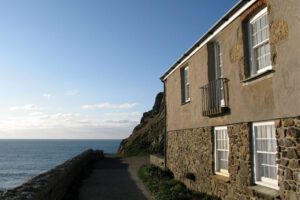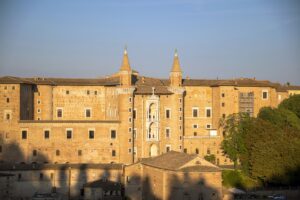7 August
Urbania’s cultural roots are deep. The Ducal Palace was built as a summer retreat for the Duke of Urbino, Federico da Montefeltro, in the late 1400’s. The Duke of Urbino brought art and culture to Urbania, and this small medieval town remains a centre for the production of desirable ceramics. Sabina Trifilo’s apartment is high-ceilinged and adorned with 19th century frescoes and the faded remains of the finer medieval ones.

Sabina contacted me to ask if I would be interested in organising an artist exchange programme between her initiative ‘Traffic’, in Urbania, and ‘Brisons Veor’, the artist organisation that I work for in Cornwall, UK. This year Sabina invited me to take part in the Contemporary Art Festival of Urbania, which takes place on October 11-13. I am to curate an exhibition of women artists’ work.
9 August
It is the day of the meeting. The artists turn up gradually, some bringing their children (it’s the summer holidays) and a contribution for lunch. It’s very hot. The children are happy to go off together and play, and after introductions we settle down to talk about the show.
I introduce the concept of the exhibition, for which I have borrowed the broad format of Judy Chicago’s seminal Dinner Party. I explain that the exhibition will have two parts: an Exhibition, but also an installation for which each artist will be invited to make a new small work, a ‘talking-point’, in their chosen medium. The installation will be a simply-covered dining table, upon which will be a small place setting for each artist, with their conversation-piece. The theme could be global warming, pollution, politics, gender issues etc…
I rely on Sabina to translate. I should have realised that language would be a barrier to easy discussion. It was over-ambitious of me to propose this project. Immediately there is dissent around ‘theme’ – some artists don’t want to tie their work to a theme imposed by others, some are already working in a specific way and don’t need to make a new piece of work. And what is the point of the ‘table’, anyway? The artists are clearly puzzled – why sit around a table and discuss their work? Why involve onlookers in the conversation? Conversations swung dizzily between the various attempts to look up Judy Chicago’s Dinner Party on the internet and Sabina’s increasingly frustrated translations of questions and objections.
I try a different approach, asking the artists to show me their work. Fairly easily achieved, because each artist has a website. But then I begin to ask, Why did that artist choose to work in that particular way? what does it mean to the artist? what is the motivation behind that piece of work? These questions confuse the group. The work is the work – it does not need explaining.
Once more I try to clarify the purpose of a theme, stressing that it is important that they are all in agreement.
During the course of the meeting I learn that one artist has several children, a business to run and a less than supportive husband, one artist is a single mother. A third member of the group makes work that obliquely addresses intersexuality, a fourth struggles for the time to make work because her husband is half-way round the world in pursuit of his own artistic ambitions. The daily difficulties and frustrations (the children are becoming fractious now) are just a part of life.

Before long it is agreed between them that a better idea will be simply to make the table function as an introduction to the exhibition, rather than the focal point. No-one feels it is useful to sit around it and share a conversation.
I begin to wonder if there is a real cultural difference in our approach as artists, and what could be the reason for that. As I understand it, the art education in Italy is quite formal; students are still taught. Does this make a difference? Is it enough then, that their work can go out into the world and stand on its own, and not expect to be interrogated, or interpreted? I am interested to know because my experience of art education in the UK is that we are encouraged to make whatever we wish, just as long as we can ‘defend’ it.
I stand by my need to know Why an artist has made a certain work. I’m not talking about the lengthy explications found on the walls of our public galleries that seek retrospectively to place the work within the artificial construct of Art History. I want to know just a little about how that work came to be, and what meaning it has for the maker – before it is celebrated, swallowed up or ignored by the establishment.
16 September
At a following meeting after I have left Italy, the artists agree that they will make work about ‘being a woman, being human’ and that the Exhibition will be called ‘Enjoy your Meal’. The dining table installation will provide a small introduction to the work of the artists on the walls. And I am to write the accompanying text.
The artists’ work is coming in, and it is highly accomplished and does indeed stand on its own, unexplained. And yet, it does address the question of women artists working in a challenging world, an outcome I could not predict on that hot day in August, struggling to grasp a word here, a phrase there, and to communicate a concept that I had hijacked from elsewhere to serve a curatorial purpose.
Patricia Wilson Smith, M.A
Visual artist/Independent curator
Jacks House Studio
St Just, Cornwall
Sept 2019
